U.S. Department of Transportation
Federal Highway Administration
1200 New Jersey Avenue, SE
Washington, DC 20590
202-366-4000
Federal Highway Administration Research and Technology
Coordinating, Developing, and Delivering Highway Transportation Innovations
|
Research & Technology Transporter This newsletter is an archived publication and may contain dated technical, contact, and link information. |
|
| Publication Number: N/A Date: August 2003 |
Publication Date: August 2003
|
For years, the water cooler served as a gathering place where professionals updated one another on projects. However, knowledge shared during an informal meeting becomes inaccessible after the fact and may not get to the ears of the people who need it most. This loss of institutional knowledge can be devastating to any industry as experts retire or change jobs, and it can cost an organization time and money in duplicated efforts, the use of old and outdated methods, and additional training needed to update new staff on the latest industry information.
On June 17, 2003, the Federal Highway Administration (FHWA) held an open house to introduce staff to the "Communities of Practice" (CoP) Web sites for the agency's Knowledge Sharing Initiative. FHWA developed the initiative and designed the Web sites to bring together groups within FHWA and outside to share knowledge in areas of common interest.
FHWA currently has 10 CoPs (also known as Knowledge Communities) available to the public at http://knowledge.fhwa.dot.gov. The CoPs feature information on a variety of topics, including high-performance concrete, roadside safety hardware, the National Environmental Policy Act, Transportation Asset Management, and the Manual on Uniform Traffic Control Devices. Each CoP enables visitors to participate in online discussions, download publications, or find contact information for experts in various subject areas.
Rumble strips were the subject of FHWA's first CoP. In 1998, after setting a goal of reducing the number of highway-related fatalities and serious injuries by 20 percent in 10 years, engineers at FHWA decided to focus on the use of rumble strips to help prevent crashes. Installed on the shoulders or centerlines of roadways, rumble strips are lines of small bumps or indentations that make a loud noise and produce a vibration when run over by a car. Engineers initially were overwhelmed with useful information on rumble strips and realized that both paper publications and CD-ROMs were inadequate for distributing updated information quickly. Therefore, FHWA created the CoP to serve as a central repository and "home base" for information on rumble strips.
Through the CoP for rumble strips (http://safety.fhwa.dot.gov/roadway_dept/pavement/rumble_strips/), visitors now can access facts on the costs and benefits of rumble strips, lists of companies that design and install them, and links to online resources and experts on rumble strips. So far, the site has proven a success: In the first month after going online, the rumble strips site received approximately 60,000 hits. Since then, the number of visits has stabilized near 1,200 visits per month, primarily by staff at State transportation agencies. Other CoPs average as many as 4,500 visits and have approached almost 1 million hits per month.
In addition to CoPs available to the public, others exist for internal use by FHWA employees. A CoP on FHWA's corporate management strategies, for example, contains information on performance measures and self-assessments. Another site features administrative information, such as organizational changes at FHWA, and reference materials available for downloading.
Through the various CoPs, FHWA is becoming more responsive to customer needs, helping spark innovation across the highway community, and improving the productivity of new staff. FHWA also has learned important lessons about creating successful online communities. For example, agencies that develop CoPs should find ways for members to stay in frequent contact with each other, provide employees with time to participate, and recognize the CoP by giving it a name, creating and disseminating member lists, and letting others know how to join the online community. FHWA's success with CoPs has been recognized with several awards from both industry and association groups.
For more information on FHWA's CoPs, contact:
Mike Burk 202-366-8035 mike.burk@fhwa.dot.gov
 |
| Screen shot from http://knowledge.fhwa.dot.gov Caption: Through the "FHWA Knowledge Communities" Web site, users can access a variety of transportation-related communities of practice. |
Effectively assessing the condition of highway bridge decks is a significant challenge to State highway agencies across the United States. The service life of decks is typically much shorter than bridge superstructures or substructures due to corrosion-related deterioration. Deck repair and replacement activities can result in traffic disruptions and undermine the efficiency of the highway system. As a result, bridge engineers have a significant interest in technologies that can detect incipient deterioration to minimize repairs and traffic disruptions. Ground penetrating radar (GPR) uses electromagnetic waves to detect subsurface deterioration, and may be an effective tool for assessing the condition of the decks.
The next generation of ground penetrating radar systems is being evaluated at the Federal Highway Administration's (FHWA) Turner-Fairbank Highway Research Center (TFHRC). Known as PERES II (Precision Electromagnetic Roadway Evaluation System), this unique project is an ultra-wideband, high-frequency GPR system designed and constructed by Lawrence Livermore National Laboratories. HERMES II is a pooled fund endeavor that developed and tested the prototype system. Nineteen States and the FHWA were participants in the pooled fund project, and they provided input into system design parameters and testing. A technical panel consisting of nine States oversaw the development and testing phase of the project.
The system, itself, consists of a high-frequency GPR transceiver and supporting electronics mounted on a robotic cart that scans the transceiver over the deck surface. Data are collected and processed to provide two- and three-dimensional reconstructions of the internal features of the deck, showing deterioration, defects, and construction details such as rebar patterns. The testing conducted as part of the HERMES II program indicated that the system was capable of imaging delaminations, a common form of corrosion-related deterioration in concrete bridge decks. The systems capabilities for imaging internal defects was significantly improved over previous technologies, and additional testing and evaluation of the system is ongoing at TFHRC. The goal of the program is to use the technologies developed on the PERES II system to develop a high-speed, portable array that can be used to inspect bridge decks at highway speed, eliminating the need for traffic control during the deck inspections.
Although the original PERES II was designed for inspecting bridges, researchers also are conducting tests to determine if the technology can be used to evaluate asphalt pavements. Because PERES II has a ability to image subsurface features at levels not previously possible, the system could be a valuable tool for testing asphalt pavements for thickness and subsurface defects.
For more information, visit www.tfhrc.gov/hnr20/nde/hermes2.htm.
Glenn Washer
Researchers in Switzerland and elsewhere in Europe have found that single-lane roundabouts-raised islands placed in intersections around which traffic circulates-can operate more safely and handle greater traffic capacity than two-way, stop-controlled intersections. Despite these benefits, however, roundabouts have been used only sporadically in the United States. One reason is that many traffic engineers and designers are not familiar with how to design and operate roundabouts under local conditions.
In June 2003, to help increase understanding of the benefits of roundabouts, the Federal Highway Administration (FHWA) hosted a presentation by Gianantonio Scaramuzza, an expert on roundabouts from the Swiss Council for Accident Prevention in Berne, Switzerland. Scaramuzza's presentation focused on the improvements in intersection safety that have taken place in Switzerland as a result of installing roundabouts. In recent years, transportation agencies throughout Switzerland installed an increasing number of these traffic-control devices. Swiss researchers found that the number of crashes with injuries decreased significantly at intersections where they constructed roundabouts. Scaramuzza added, however, that although the rate for crashes with injuries went down, the total number of crashes did not necessarily decrease at all roundabouts.
Based on results from two before-and-after studies of roundabouts in Switzerland, Scaramuzza presented several recommendations for designing roundabouts. First, he suggests that engineers limit the diameter of roundabouts to between 24 meters (78.7 feet) and 32 meters (105 feet). Studies have shown that the annual number of crashes increases at roundabouts with dimensions larger or smaller than this. Second, Scaramuzza recommends that roundabouts have single-lane approaches only. Researchers in Switzerland found that the number of crashes at intersections having roundabouts with multilane approaches increased compared to the situation before the roundabout was built. Intersections featuring roundabouts with only one approach lane, on the other hand, experienced fewer crashes. Note that in the United States, United Kingdom, Australian and French experiences, roundabouts with double lane entries have been effective in reducing injury and fatal crashes when designed properly. Geometric design has to optimize speed reduction at entries and avoid path overlaps.
Scaramuzza's third recommendation is that the entry angle-the angle between the entry roadway and the circulating roadway-of roundabouts should be greater than 40 degrees. Studies of the correlation between crashes and geometric characteristics of roundabouts have shown that roundabouts with skew angles at entries less than 40 degrees are not as safe. This observation is true only for single entry lane roundabouts, although the opposite is true for roundabouts with double lane entries. Moreover, the capacity is reduced when the entry angles are more perpendicular, whether for single- or double-lane entry roundabouts.
Fourth, Scaramuzza recommends that engineers construct roundabouts so that drivers in the roundabout have a line of sight down the approaching roads of less than 5 meters (16.4 feet) or greater than 30 meters (98.4 feet), as research indicates that this also will help improve safety.
Finally, Scaramuzza recommends not including bicycle lanes in roundabouts. He explained that including separate bicycle facilities within the circulating roadway of a roundabout could lead to bicycle-vehicle crashes as vehicles enter and exit the roundabout while bicycles simultaneously travel around the perimeter of the roadway. Refer to the FHWA Roundabouts: An Informational Guide for recommendations and more information on bicycle facilities.
In the United States, FHWA and its partners are conducting several ongoing research projects involving roundabouts. FHWA and the Transportation Research Board are jointly funding a study to analyze roundabout safety, develop models for capacity and delay, and update recommendations on the geometric design of roundabouts. In addition, FHWA currently is finishing a report on paths and speed at double-lane roundabouts and starting a new study to find better ways to accommodate visually impaired pedestrians at roundabout crossings.
For more information about the use of roundabouts in Switzerland, contact Gianantonio Scaramuzza at +41 31 390 21 45 or g.scaramuzza@bfu.ch. For more information about roundabouts in the United States, contact:
Joe Bared 202-493-3314 joe.bared@fhwa.dot.gov
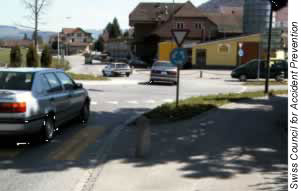 |
| Roundabouts like this one in Switzerland offer many safety benefits and can increase traffic capacity at intersections. |
Nearly two decades ago, the Federal Highway Administration (FHWA) developed the Federal Outdoor Impact Laboratory (FOIL) at the Turner-Fairbank Highway Research Center in McLean, VA. FHWA designed the lab so researchers could perform crash tests and study the complex interactions between a motor vehicle, its occupants, and roadside objects during a collision. Since then, researchers have performed numerous crash tests, primarily using a propulsion system that relied on gravity to move the vehicles.
Recently, researchers at FHWA developed a new system that propels vehicles using a hydraulic motor, rather than gravity, on a closed-loop track, allowing better control of the vehicles.The new hydraulic system uses five main components to propel the vehicles-an electric motor, nitrogen tanks, piston-cylinder accumulators, hydraulic motors, and a drive system. The electric motor drives a hydraulic pump that feeds oil into the lower portion of the piston accumulators. Nitrogen from the tanks is fed into the upper portion of the accumulators, which compresses the hydraulic oil. Valves to the nitrogen tanks and the hydraulic pump then are closed off, and the compressed oil is released to the hydraulic motors. The motors then accelerate a cable and trolley attached to the vehicle, propelling the vehicle to the desired speed for the crash test.
When using one hydraulic motor, the new system can accommodate vehicles weighing up to 2,000 kilograms (4,404 pounds) at speeds in excess of 100 kilometers per hour (62.1 miles per hour). Researchers recently installed a second hydraulic motor for testing heavier vehicles. With the second motor, the capacity of the system increased, enabling researchers to test vehicles weighing up to 8,000 kilograms (17,616 pounds) at speeds of more than 80 kilometers per hour (49.7 miles per hour).
In addition to using hydraulics rather than gravity to propel the vehicles, the new system provides many other benefits. The closed-loop track gives researchers the option to abort a test. Also, researchers have greater control over vehicle speed. Using one motor, researchers can adjust speeds to within plus or minus 0.5 kilometers per hour (0.3 miles per hour). Speed accuracy with two motors and a larger vehicle is approximately 1.0 kilometer per hour (0.6 miles per hour). Another benefit is that researchers can control the whole system using one computer, whereas the old system was controlled manually.
Leonard Meczkowski
For more information, contact:
Abdullatif (Bud) Zaouk 703-726-3540 zaouk@ncac.gwu.edu
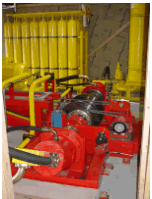 |
| The hydraulic propulsion system, shown here, includes nitrogen tanks (yellow bottles, back left) and a drive system with two hydraulic motors attached at each end. |
A primary cause of scour (erosion), fast-moving water swirling around bridge piers can lead to bridge collapse. These circular water flows (vortices) act like miniature tornadoes that erode particles from the streambed, eventually creating holes around the bridge foundation. Until recently, engineers were unable to measure the impact of these vortices, even in a laboratory.
The Federal Highway Administration (FHWA) is studying a relatively new technique, known as particle image velocimetry (PIV), to measure the velocity-distance and direction traveled over time-of tracer particles suspended in the water. Based on this testing, FHWA anticipates that PIV could be a cost-effective way for engineers to visualize and measure the vortices that cause scour around bridge piers and develop more reliable methods to predict the depth of scour around the foundations.
To conduct the PIV studies, researchers at FHWA developed a computer-controlled instrumentation system that uses a laser to illuminate a plane in the water flow. The laser pulses in time intervals measuring only a fraction of a second, and a high-speed, high-resolution digital camera records the position of particles in the plane.
By recording thousands of particle images over several minutes and analyzing them with computer software, the researchers can generate reliable velocity measurements quickly. Using this data, researchers can quantify the shear stress-or friction between the water and the streambed- and determine the strength of the vortices that create the scour holes that threaten structural stability.
In tests of the PIV system at the Hydraulics Laboratory at FHWA's Turner-Fairbank Highway Research Center in McLean, VA, researchers found a potential correlation between shear stress and the maximum scour depth around bridge piers. If further testing confirms the correlation, then researchers could use the PIV system in the future to predict the depth of scour at a relatively low cost and in a shorter time than the more expensive and time-consuming tests now used.
In addition to testing for shear stress and scour depth, the PIV system has other potential uses. The system could be used to test possible countermeasures, such as techniques for altering water flows around bridge piers. The PIV system also has applications in the design of more efficient drainage structures. In a study for the South Dakota Department of Transportation, researchers at FHWA used the PIV system to determine the best shape for the entrance of a storm sewer. They tested six bevel shapes for the culvert opening and determined which shape allowed for the maximum water flow.
For more information on the PIV system and its use in bridge pier and culvert studies, contact Kornel Kerenyi at 202-493-3474 or kornel.kerenyi@fhwa.dot.gov.
Sterling Jones
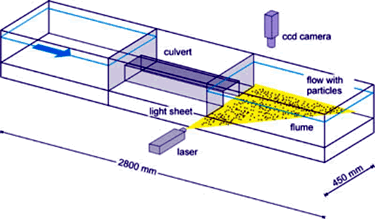
Caption: In this illustration of a PIV setup for culvert experiments, a laser illuminates particles in the water and a camera captures images of the particles in the plane of flow.
Credit: none needed, FHWA
In 2002, more than 42,000 people died in crashes on the Nation's roadways. In addition, crashes cost society more than $230 billion per year and consume a greater share of the country's health care costs than any other cause of illness or injury. The largest cause of these crashes is driver error-as cited in more than 90 percent of police crash reports.
In 1998, the U.S. Department of Transportation (USDOT) developed the Intelligent Vehicle Initiative (IVI)-a multiagency partnership with the automotive industry and its suppliers to help accelerate the development and commercialization of vehicle-based products that can warn drivers of dangerous situations, recommend actions, and even assume partial control of vehicles to avoid collisions. On June 25, 2003, as part of USDOT's 3-day National IVI Meeting and Demonstration, USDOT held a panel discussion in Washington, DC, to discuss the progress that IVI has made to date and the benefits and future of intelligent vehicles.
Speakers during the session included administrators and deputies from USDOT's agencies that participate in the IVI program: the Federal Highway Administration (FHWA), the Federal Motor Carrier Safety Administration (FMCSA), the National Highway Traffic Safety Administration (NHTSA) and the Federal Transit Administration (FTA). FHWA's IVI focus areas are specialty vehicles, such as ambulances, and cooperative vehicle highway systems. The first cooperative vehicle highway system or "intelligent intersection" test facility was unveiled during the conference at the FHWA's Turner-Fairbank Highway Research Center in McLean, Virginia.
The panel session attracted participants from across the country, including engineers, researchers, and project planners from Federal, State, and local transportation and transit agencies; academia; and private industry. Jeffrey Paniati, associate administrator of operations and acting director of the Intelligent Transportation Systems (ITS) Joint Program Office at the FHWA, moderated the discussion.
The first presenter, Dr. Jeffrey Runge, administrator of the NHTSA, explained that while the number of vehicle miles traveled (VMT) nationwide increased by 2 percent from 2001 to 2002, the highway fatality rate stayed the same at 1.5 per 100 million VMT. To achieve the USDOT goal of 1 fatality per 100 million VMT by 2008, thousands of additional lives will need to be saved each year. According to Runge, the key to achieving this goal lies in the development and deployment of intelligent vehicles and technologies that can change driver behavior and enhance the ability of vehicles to withstand crashes. Examples of such technologies include systems that can mitigate driver drowsiness, provide warnings about potential rear-end crashes, and detect alcohol-impaired drivers.
Following Runge's presentation, Annette Sandberg, administrator-designate of the FMCSA, and Barbara Sisson, associate administrator of the FTA, talked about the future of IVI in the commercial vehicle and transit sectors. They highlighted recent developments, such as technologies to avoid collisions and systems that can prevent vehicle rollovers, improve braking, and facilitate lane tracking. Ultimately these systems will help foster safer highways and more reliable transit service, and result in greater cost savings. Sandberg and Sisson also stated that future IVI efforts will focus on technology integration, widespread deployment of intelligent vehicles, and new safety areas, including enhancing driver vision and improving the operation of signaling systems.
FHWA Administrator Mary E. Peters was the final speaker. Peters began by asserting that IVI will help reduce driver error and associated deaths. Peters went on to note that although public outreach efforts and infrastructure technologies have helped reduce roadway departures and intersection and pedestrian fatalities, "[W]e have only seen the tip of the iceberg in terms of what technology applications can do to save lives on our Nation's highway systems." She maintained that the role of IVI is critical, but also emphasized the need to continue to maximize the "4E approach"-engineering, education, enforcement, and emergency response-and to keep building partnerships between the automotive industry and Federal, State, and local agencies.
Following the panel discussion, Jeffrey Shane, the USDOT under secretary for policy, explained how the Department plans to continue supporting these efforts. President George W. Bush's proposed Safe, Accountable, Flexible, and Efficient Transportation Equity Act (SAFETEA) of 2003, for example, calls for increased funding for research into intelligent vehicles.
In addition, Shane highlighted the need to continue accelerating the commercialization of intelligent vehicle technologies and developing the next stage of the IVI program, which will emphasize vehicle-to-vehicle and vehicle-to-infrastructure cooperation. According to Shane, these advanced systems can support the greatest degree of safety in complicated driving scenarios at intersections and during lane changes. For more information about IVI and the national IVI meeting, visit http://www.its.dot.gov/ivbss/index.htm .
Susan Slye 202-366-1068 susan.slye@fhwa.dot.gov
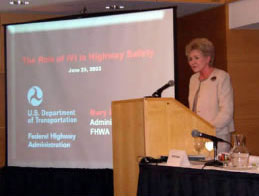 |
| FWHA Administrator Mary E. Peters addresses participants at the National IVI Meeting held in Washington, DC, on June 25, 2003. |
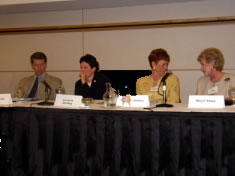 |
| From left to right, Jeffrey Runge, Annette Sandberg, Barbara Sisson, and Mary Peters participate in the panel discussion. |
In 2000, more than 2.8 million crashes occurred at intersections, representing 44 percent of all reported crashes. In addition, approximately 8,500 people died at or within intersections. As part of the National Intelligent Vehicle Initiative Meeting on June 24-26, 2003, the U.S. Department of Transportation (USDOT) demonstrated innovative technologies at the Federal Highway Administration's Turner-Fairbank Highway Research Center in McLean, VA. During the 3-day event, participants viewed the demonstrations from the roadside and had the opportunity to ride in the test vehicles.
These innovations, developed under the USDOT Intelligent Vehicle Initiative and FHWA's partnerships with the states of California, Minnesota, and Virginia, as the Infrastructure Consortium, are part of the USDOT ongoing research and development to help prevent crashes and save lives. A highlight of the demonstrations was the unveiling of America's first "intelligent intersection" test facility. Researchers from the University of California at Berkeley, University of Minnesota, and Virginia Polytechnic Institute and State University (Virginia Tech) developed the new intersection technologies that were demonstrated.
The system designed in California uses a laser radar sensor at an intersection to detect approaching vehicles. Using a timing algorithm, the roadside computer monitors the speeds of the approaching vehicles and determines when a left turn would not be safe. During the demonstration, as one vehicle approached an intersection in preparation to make a left turn, a large road sign reading "No Left Turn" flashed to warn the driver in the left-turning vehicle of an approaching vehicle that could not be seen. The message on the sign seemingly grew 50 percent in size as it flashed. The researchers found that this type of sign is especially visible to drivers when placed just above eye level on the opposite corner of the intersection.
Thirty percent of all crashes in rural areas occur at intersections, which was the reason for developing a different type of technology. Researchers at the University of Minnesota demonstrated a system designed to help drivers identify unsafe gaps in high-speed traffic at two-way, stop-controlled intersections in rural areas. Their system consists of an array of ground-mounted radars interconnected through wireless technologies. The radars collect data on the speed and location of approaching vehicles and send the data to a roadside computer that calculates and identifies unsafe gaps in the approaching traffic. When the system detects an unsafe gap, it triggers a roadside sign to warn the waiting traffic that it is dangerous to enter the intersection.
In the third demonstration, Virginia Tech researchers established an infrastructure approach to alert drivers of an imminent traffic signal violation. Roadside radar sensors detected each vehicle's location and speed, so the system could determine whether a vehicle would cross into an intersection during the red light phase of a traffic signal. If the system predicts a violation, an electronic graphic "Stop" sign hanging between the traffic signal heads illuminates as a warning to the violating driver approaching the intersection.
In the fourth demonstration, Virginia Tech showed how an infrastructure-vehicle cooperative system could be used to prevent signal violations. The system contains a roadside traffic signal controller that provides information about signal phase and timing, an infrastructure-to-vehicle communications system, an in-vehicle global positioning system receiver and associated roadway map representation, and an in-vehicle computer and driver-vehicle interface. With this information, the system recognized that the driver of a vehicle was not going to stop at the red light intersection using an audible tone, plus a display on the dashboard that included a graphic "stop sign" icon. View the intersection demonstration online at https://www.fhwa.dot.gov/ivi/demo1.htm.
A number of other technologies were on display, including a bus from the San Mateo County Transit District equipped with a frontal collision warning system and a car containing an adaptive cruise-control system. Several trucking companies also demonstrated new technologies. For example, one truck was equipped with a lane-departure warning system to alert drivers when they are drowsy and having trouble staying in their lanes. Another truck was equipped with a system that helps prevent rollovers by automatically reducing engine power or applying the engine brakes when sensors detect a near-rollover situation.
The Intelligent Vehicle Initiative is a cooperative effort between the Federal Highway Administration, the Federal Motor Carrier Safety Administration, the National Highway Traffic Safety Administration, the Federal Transit Administration, the motor vehicle industry and its suppliers, universities, and State and local transportation agencies. More information about the initiative and the technologies is available at www.its.dot.gov.
Susan Slye 202-366-1068 susan.slye@fhwa.dot.gov
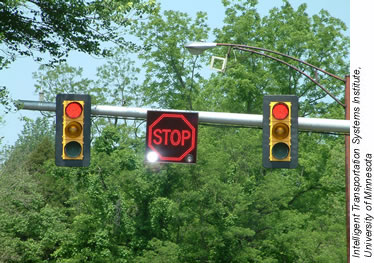 |
| Minnesota's Intersection Decision Support system uses an illuminated stop sign to prevent drivers from entering an intersection during the red light phase of a traffic signal. |
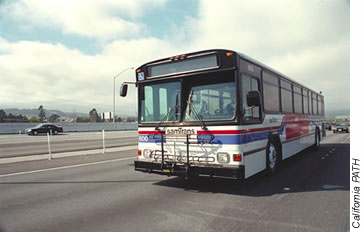 |
| Light emitting diodes are used to warn bus drivers of collision hazards at the front of the bus. |
In May 2003, the Federal Highway Administration's (FHWA) Resource Center, in partnership with the Federal Lands Highway Division, and in cooperation with the Office of Research, Development, and Technology sponsored a conference to share best practices in technology deployment and to provide professionals with the tools to overcome these and other challenges. Conference participants also learned about the role that technologies can play in helping FHWA achieve its strategic goals of safety, environmental stewardship and streamlining, and congestion mitigation.
Through brainstorming sessions, live demonstrations, and presentations, participants learned how to select, deploy, and promote technologies and innovative practices more effectively. During one brainstorming session, participants discussed ways to improve the proposal process for technology deployment projects at FHWA Resource Center locations. Each year the Resource Center locations receive proposals for hundreds of technology transfer projects, but they can fund only a small number of proposals, and narrowing down the submittals can be a time-consuming task. One participant suggested posting the proposals on a Web site, thereby establishing a central location where staff can download and review each document. Additionally, researchers submitting proposals could use the site to identify opportunities to partner with other groups performing similar work and possibly resubmit their documents as joint proposals, reducing the number of proposals submitted to FHWA.
Several groups including officials from FHWA's Central, Western, and Eastern Federal Lands Highway Division offices and headquarters' program offices gave presentations on various projects demonstrating how these initiatives drove the FHWA's strategic goals. A representative from the Western Federal Lands Highway Division (WFLHD), for example, discussed the Road Surface Analyzer (ROSAN) vehicle and its contribution to mitigating congestion. Traveling at highway speeds, the ROSAN vehicle measures pavement smoothness without disrupting traffic flow.
WFLHD also presented the Laserlux vehicle, which measures the retroreflectivity of pavement markings on highways. Researchers use data from the Laserlux vehicle to ensure that markings are visible to drivers, thereby improving highway safety. Both vehicles were on display at the conference, and attendees participated in firsthand demonstrations to learn about vehicle uses.
Held in Vancouver, WA, the 3-day conference attracted more than 60 participants, including technology transfer coordinators, researchers, and field staff from FHWA Division Offices, Local Technical Assistance Program centers, and the National Association of County Engineers. In previous years, each Resource Center hosted its own conference. This year, FHWA held one conference to help ensure the consistency of the training and technical expertise that the centers provide across the country. Feedback from this year's participants was positive, and FHWA anticipates holding the conference annually.
For more information, contact:
Susanna Hughes Reck 303-716-2292 susanna.hughesreck@fhwa.dot.gov
Timothy Barkley 404-562-3732 timothy.barkley@fhwa.dot.gov
Mark Sandifer 708-283-3528 Mark.sandifer@fhwa.dot.gov